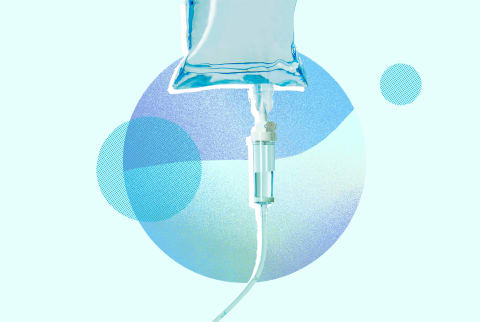So what’s the verdict on this integrative treatment, and does it warrant the fanfare? We investigated. It is not the only way to support NAD+ levels in the body, of course. It is also possible to increase NAD+ levels through oral supplementation of one of its precursors, such as niacin (vitamin B3), nicotinamide, and nicotinamide riboside (NR), the last option being a direct precursor2, and has been shown to be the most effective at supporting your natural levels of NAD+. You can also support natural levels of NAD+ by lifestyle choices, such as regular HIIT workouts and caloric restriction and fasting diets. The second safety concern is where you are getting it, notes functional and integrative medicine practitioner Roxanna Namavar, M.D., board-certified psychiatrist and fellow in the American Academy of Anti-Aging Medicine, who uses it at her own practice. “No matter what IV therapy you are getting, you want to make sure your practitioner knows where the ingredient is sourced, and how it is compounded. They should also tailor your infusion treatments to you: It shouldn’t feel like you’re picking things off a menu. Your practitioner should look at your lab work, symptoms, and goals and create a protocol that is specific to your needs.” This concern comes to light most notably with the large amounts of IV bars that have popped up lately, most without much regulation. The U.S. Federal Trade Commission recently took action against an IV drip bar for making unsupported health claims3 about their ability to treat serious illnesses such as cancer, multiple sclerosis, or congestive heart failure. If done under the supervision of a responsible health care practitioner, however, Namavar says there are no significant safety concerns. She notes that some patients may be sensitive to IV NAD+ therapy, specifically, and experience discomfort such as warming of the chest and nausea. Wally Taylor, M.D., a functional medicine physician with Texas Integrative Medicine in Austin, Texas, notes similarly, “One of the things about NAD+ is that you can’t infuse it too quickly without it being pretty uncomfortable.” He says some of his patients, “say they feel like they’re having symptoms of a heart attack, but when we look at their heart monitor, we don’t see any evidence of that.” He has found that breathing high-concentration oxygen during the infusion can reduce some of these side effects. “Any time you’re giving treatments intravenously, there could be problems of one sort or another,” says Taylor. “So it’s useful to have the direct oversight of a health care provider who has experience with NAD+.” He says complications are more likely to arise in people with a chronic illness, but it’s not impossible for healthy people to have a bad reaction. Cost is another issue. A single IV NAD+ therapy ranges from several hundred dollars to $1,000 or more. You also have to factor in travel time to the clinic and the wait time—infusions generally take two or more hours, and some people may need infusions several days in a row. She notes that there are multiple “ideal patients” for IV NAD+ therapy, from patients feeling run-down to those struggling with drug addiction (IV NAD+ therapy has been used in addiction treatment centers to help people who are going through withdrawal and help regain energy while rehabbing). Taylor also recommends IV NAD+ therapy for some of his patients because it “rapidly restores the body’s levels of NAD+ and helps the NAD get to the cells and tissues where you want it to have an effect.” Taylor says many of his patients benefit from IV NAD+ therapy. “A lot of them are deficient in NAD+ and have problems with their mitochondrial function, as far as producing energy for their bodies,” he says. But Taylor also has patients—including those over 50 years old—who seek out NAD+ therapy in order to restore their peak performance in marathons, triathlons, and other athletic events. “Clinically, [IV therapy] seems to be the strongest way to boost NAD+ levels and have an impact,” says Sommer White, M.D., an integrative and functional medicine physician in Nashville, Tennessee. “Taken on consecutive days, it seems to be even more beneficial.” After six hours, NAD+ levels in the blood had increased about fourfold. Unexpectedly, blood levels of NAD+ didn’t start to rise until two hours after the start of the infusion. The researchers say this may be because the NAD+ was being completely taken into the tissues or broken down into other compounds. While the study shows that this dose of IV NAD+ is well tolerated by healthy people, more research is needed to know what benefits IV NAD+ therapy has for supporting mitochondrial function or maintaining healthy aging. We also know that there are other effective, easy ways to boost your NAD+, including supplements, that have been shown to be safe and effective. Finally, we know you can also use lifestyle changes like diet and exercise to increase your NAD+ levels while gaining many other health benefits at the same time.




